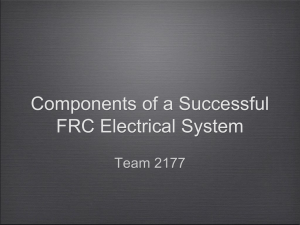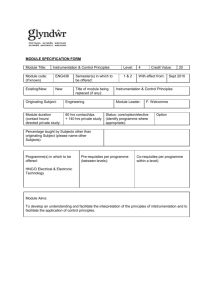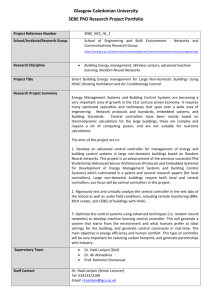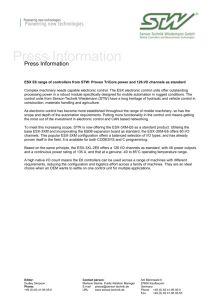Notes on the History of ASI Controls
advertisement
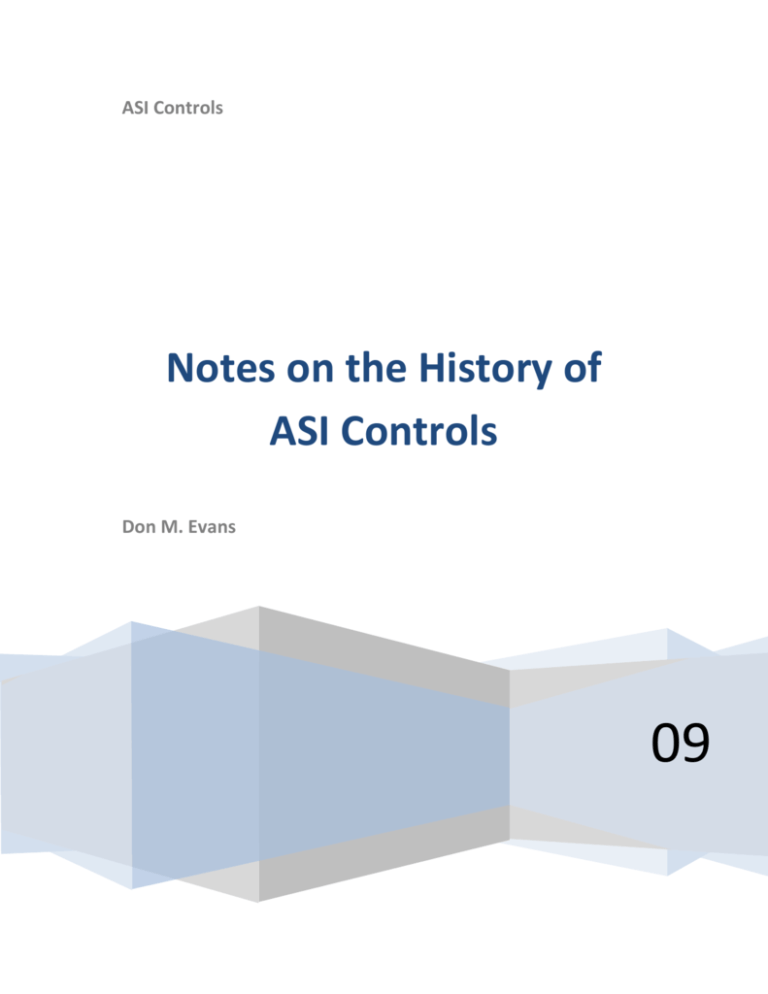
ASI Controls Notes on the History of ASI Controls Don M. Evans 09 Notes on the History of ASI Controls 1. Born at a lunch table meeting in a Berkeley Marina Hotel on December 23, 1985. 2. The Genesis of the product, still with no company name decided upon, was to include a new emerging concept called ‘distributed intelligence’. This was a major departure from the control methods almost universally followed by others in the Controls field: The use of a centralized ‘brain’, monitoring remotely located input sensors, and controlling remotely placed actuators, based on calculations in the central processor. 3. Distributed intelligence implies a ‘brain’ of some sort located at the remote terminal locations, monitoring the sensors located there and controlling the actuators at the remote terminal. To accomplish this, it would be necessary to include a micro-processor at EVERY terminal location. 4. Distributed intelligence would not be meaningful if there was not a way provided to communicate between the terminal location and some centrally located office wherein building management strategies could be implemented. So, the Genesis of the ASI Controller must include a communication path, and to avoid a spider web of cabling from every remote terminal to the central office, it was decided that a single cable would be provided for a number of terminal controllers, each being connected to the cable in such a manner as to avoid interrupting communications if any single or group of controllers should lose power or have other difficulties. 5. Casting about in the controls industry, we simply could not find such a ‘ready-built’ device, so we were in the position of having to ‘invent’ the thing ourselves. 6. Emerging technology was providing a means of creating one’s own special purpose circuitry on Silicon, miniaturized so as to consume little power, be small in size and perform whatever specific functions that might be required. This technology became known as Application Specific Integrated Circuitry, hence the name ASI Controls! 7. We contracted with Sierra Semiconductor to provide us with the necessary tools and design capability to create a circuit that would include: a Microprocessor, non-volatile memory and analog and digital circuitry to create a ‘Controller on a Chip’. As the design process proceeded, it became clear that the industry had not yet reached sufficient maturity to include a complex microprocessor on the same silicon chip alongside the memory and analog circuitry. It was decided to include non-volatile memory to keep necessary data in place during power outages, analog-to-digital input and digital-to-analog output conversion circuitry as well as the required logic to provide terminal control, on the chip and utilize an off-the-shelf microprocessor to complete the controller. 8. Another requirement to provide power to actuators caused us to scan about for something useful to replace large and bulky relays. Having had some experience with multi-layer silicon devices in a previous life, we looked into the possibility of using Triacs, four-layer silicon devices that could allow control of an alternating current (AC) power line from a single direct current (DC) control line. Since this was relatively new in concept we worked very closely with Triac manufacturers to help them design their Triacs to be controlled from low voltage logic circuitry. 2 9. Perhaps the most difficult part of starting with a brand new concept of distributed control, was finding a means by which air flow in the ducts associated with the terminal could be economically measured. This led to working closely with MicroSwitch Company to develop an integrated circuit version of the old ‘hot-wire’ anemometer. After many missteps in production and extensive diagnostic work by us, a useable product was obtained and went on to be the standard for ASI Controls as well as our newly emerging competition. 10. The next step in the development of distributed terminal controls was to understand the various types of electrical noise generated during normal as well as abnormal operations within a commercial building. Our first prototypes were developed with what is known as single-layer printed circuit technology and these early units did not fare well under extreme noise conditions. Visiting Beta test sites for our new controllers, using diagnostic equipment monitoring building power lines, we discovered that terrible glitches on the lines were caused when high-speed elevators were stopped. In order to stop rapidly, a dead short was placed across the inductance of the drive motor, causing extremely high voltage spikes to be broadcast throughout the buildings power grid. Such electrical noise caused our so-called non-volatile memory to become volatile! None of this information had heretofore been available because distributed controlling had not been attempted prior to our work. 11. We solved the noise problem by moving to multi-layered printed circuit boards wherein the power and common layers were separated from the logic and analog circuitry and provided a shield to the sensitive circuitry surrounding the microprocessor. 12. Communications became an integral part of the ASI Controls philosophy, since the collection of data from throughout a building was an important attribute of distributed and intelligent control. Because of the extensive electrical noise environment within commercial buildings, we found it appropriate to select a communications technique that was tolerant of noise and capable of operating in an environment where the building grounds could be four to five volts different from one another, making it impossible to utilize techniques that depended upon common mode voltages of zero. We selected a balanced-line single pair cable technique that could operate satisfactorily with common-mode voltages up to +/- seven volts. Using a single pair of wires allowed reception and transmission on the same wires. Remembering that many controllers were to be connected to the same pair of wires, a communications protocol had to be developed that provided non-interfering message transmissions, meaning that a polling system was put into place, with individual controllers remaining silent until their address was interrogated for data. 13. All of this work was performed within the context of a Variable Air Volume (VAV) terminal controller. As our Beta sites proved the efficacy of our approach to Distributed Intelligent Controls, we expanded terminal controllers to include Fan Coil units as well as Heat Pumps. 14. Our first orders were for VAV controllers, 1,500 being installed in the Norwest Building in Minneapolis, 1,000 zone controllers in the Wilshire and Figueroa Building in Los Angeles and over 650 zones at Gateway Plaza. Because communications wiring was always trailing installation and configuration of Terminals, laptop computers were utilized by Air Balancers to setup the initial conditions within the non-volatile memory of our controllers. 3 15. Because VAV terminals come in a number of flavors, subsequent development of ASI Controllers included Dual-Duct, using two air flow measuring devices, and Volume and Pressure tracing controllers for use in UM and Beaumont Hospitals. All of these utilized the same basic printed circuit board, with a second air flow sensor attached. Fan Coil and Heat pump designs were on identical boards with the air flow sensor portion truncated off. 16. ASI Controls has developed a wide range of Controllers suitable for control of equipment far more complex than a VAV terminal. We have created configurable controllers for Air Handlers, Chillers, Boilers, and other tasks, some of which are outside the realm of HVAC. All of the larger controllers have provision for communicating with a string of terminal controllers so that the data required for maintaining adequate environmental control is truly distributed and acquired only as needed to implement a control strategy. 17. Our early ‘front-ends’ that were used to communicate with our terminal controllers and larger controllers, were based on DOS graphics and appear now to be primitive, but were state-of-theart in the middle and late 80’s. ASI has now completely replaced all the early software with Windows software, completely current with all modern software and graphical technology. 18. Over the years extending from those early controllers to our most modern hardware, there have been numerous evolutionary changes resulting from emerging technology, component availability, manufacturing and assembly technological requirements and regulations imposed on electrical hardware installed in commercial enterprises. 19. In 2008, ASI made a move in the ‘green’ direction, resulting in the adoption of lower powered microprocessors. Although initial testing indicated satisfactory performance, some units suffered occasional ‘lock-up’ requiring power reset. We engaged in an immediate and intensive analysis of the problem and the results of that endeavor are available separately in a document: “ASIC/1-6000 Diagnostic Results”. 20. Over the past few years, ASI Controls has moved on to a complete replacement of our early product line, using tried and true technology that better represents the best that can be achieved in state-of-the-art hardware. This includes lower power hardware, much faster communications extending even to access of individual controllers through the Internet. Even damper and water actuators have evolved over time so that the best is utilized by ASI. The control algorithms contained within our controllers still provide the building manager with the best control and information that has always been a trademark of ASI Controls. 4

